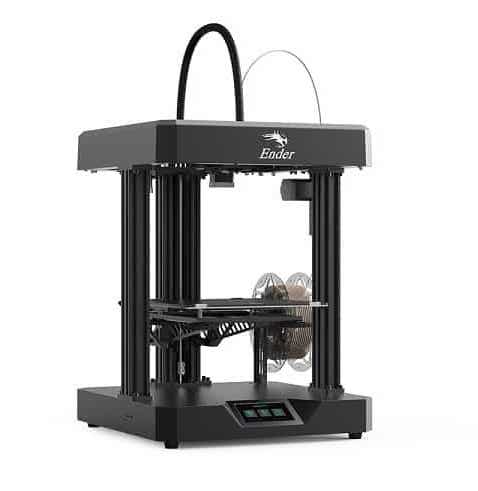Compare Ender 7 vs K1 Max
Comparison between the best 3D printers
Choose the best 3D printer at the best price. The cheapest 3D printers are here.
Buy a 3D printer here with 3D Fila.
 |
 |
|
| Model | Ender 7[BUY Ender 7] |
K1 Max[BUY K1 Max] |
| Printing Material | Filament | Filament |
| Buy Filament for Creality 3D Ender 7 | Buy Filament forCreality 3D K1 Max | |
| Estimated price | $429,00 | $1300,00 |
| Manufacturer | Creality 3D | Creality 3D |
| Release Year | 2021 | 2023 |
| Print Volume [mm] | 250x250x300 | 300x300x300 |
| Printer Size [mm] | 430x460x570 | 435x462x526 |
| Weight [kg] | 17,2 | 18 |
| Power Loss Recovery | YES | YES |
| Enclosed printer | NO | YES |
| Bed Leveling | Manual | Automatic |
| Filament End Sensor | YES | YES |
| Bed type | Heated | Heated |
| Power supply system | Bowden | Direct Drive |
| Standard nozzle | 0,4 | 0,4 |
| Maximum Nozzle Temperature [°C] | 260 | 300 |
| Maximum Bed Temperature [°C] | 100 | 100 |
| Maximum printing speed [mm/s] | 250 | 600 |
| Filament holder | YES | YES |
| Camera for supervision | NO | NO |
| Recommended filaments | PLA, PETG, Tritan, Flex, ABS | ABS, PLA, PETG, TPU, PA, ASA, PC, PLA-CF, PA-CF, PET-CF |
| Recommended slicers | Cura, Simplify, Slic3r, IdeaMaker | Creality Print, Cura, Simplify, Slic3r, IdeaMaker e outros |
| Maximum Resolution [mm] | 0,1 | 0,1 |
| Processor | Creality CR-FDM V.2.4.S1_V101 32bits | |
| Display | Display touchscreen 4,3'' | Display touchscreen 4,3'' |
| Power Supply | 110/220V / 350W | |
| Connectivity | SD / USB | USB / Wi-Fi / Ethernet |
| Operating systems | Windows, Mac, Linux | Windows, Mac, Linux |
| Date of registration in the system | 2022-11-04 | 2023-12-01 |
| Release date | 2021 | 2023 |
| Extra features | Crealitys Ender 7 printer offers remarkable print speeds, utilizing CoreXY kinematics for precise and fast movement. With a 250x250x300mm build area, dual direct extruder, and custom hotend, the Ender 7 is capable of printing at high speeds, although quality may suffer on smaller prints. Assembly is relatively straightforward, but the machine is noisy and can get hot. Its true speed potential is most noticeable on larger prints, where it outperforms its competitors. | The Creality K1 Max stands out as a fast Core XY 3D printer with a large build volume of 300 x 300 x 300 mm. It is fully enclosed and equipped with AI sensors to prevent print failures. This model has a smooth and flexible PEI build platform, and uses an automatic leveling system with LIDAR, as well as a filament run-out sensor. LAN, Creality Cloud and USB Flash Disk connectivity are available, as well as a 4.3-inch touchscreen interface. The K1 Max is robust, weighing in at 18 kg, and includes an AI camera and limited version of the Klipper firmware. Its motion system is solid and the printer is efficient with high-temperature filaments, but it is not silent. Assembly is 99% complete, requiring only minor adjustments before use. |
| Support for multiple colors and materials (AMS and CFS) | NO | NO |
Notes * |
||
| Cost-benefit | 7 / 10 | 7 / 10 |
| Hardware | 2.4 / 10 | 4.8 / 10 |
| Tela | . | . |
| Print volume | 4 / 10 | 4 / 10 |
| Performance | 2 / 10 | 5 / 10 |
| [BUY Ender 7] | [BUY K1 Max] |
Conclusion |
| In comparing the Ender 7 and K1 Max 3D printers from Creality 3D, several key factors emerge that can guide potential buyers in their decision-making process. The Ender 7 presents itself as a budget-friendly option with a respectable print volume and impressive maximum printing speed. Its straightforward assembly and manual bed leveling may appeal to users looking for a more hands-on experience. However, while it offers decent performance, it may not be as versatile as a more premium model and could produce inconsistent quality on smaller prints. Its cost-benefit ratio reflects this balance of affordability and basic functionality. On the other hand, the K1 Max, while significantly more expensive, offers enhanced performance and features that justify its price. With a larger build volume and advanced capabilities such as automatic bed leveling, a fully enclosed design, and high-temperature filament compatibility, it caters to more demanding projects and materials. Its robust construction and smart connectivity options further support its usability in various settings, although its assembly requires only minor adjustments after delivery. In terms of cost vs. performance ratio, the K1 Max shines with a higher rating thanks to its advanced technological features and improved print reliability, making it better suited for users who require high-efficiency outputs and flexibility with filament types. However, for hobbyists or those new to 3D printing, the Ender 7 offers adequate performance at a lower price, making it a great entry-level choice. Ultimately, the decision on which printer to choose will hinge on individual priorities: if budget and simplicity are paramount, the Ender 7 is the way to go. Conversely, for users seeking to leverage more sophisticated technology for intricate projects, the K1 Max represents a worthy investment. |

